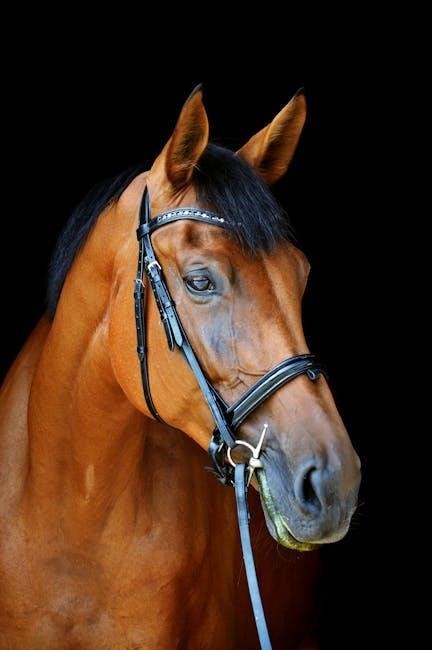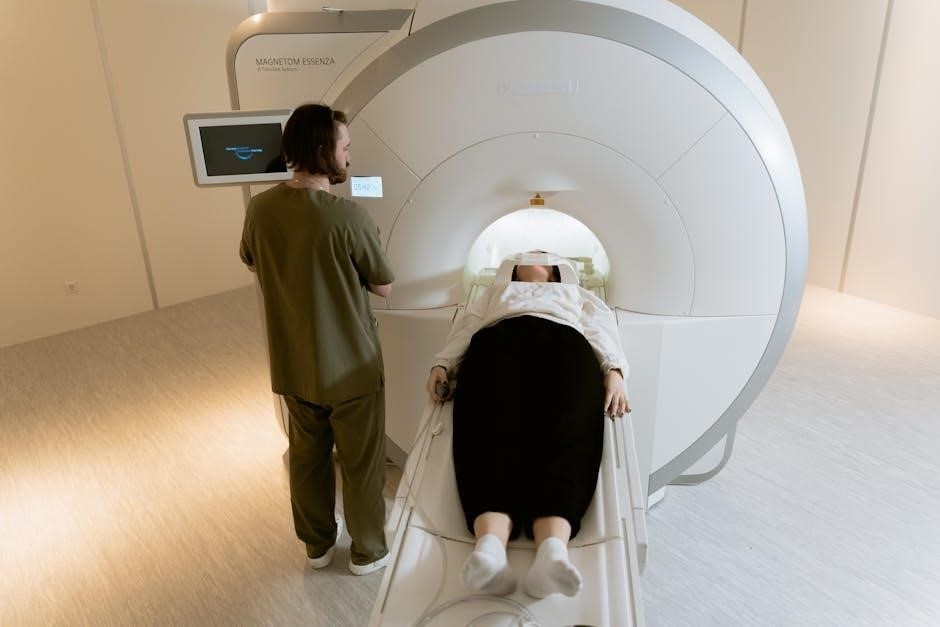
novice 27 2007 dressage test pdf
The Novice 27 2007 Dressage Test is a foundational competition designed for horses and riders at the early stages of their dressage journey․ Introduced in 2007, it reflects modern training methods and competition standards, emphasizing clear communication between horse and rider․ Based on the British Riding Clubs’ Novice Horse Trials test, it evaluates basic skills, balance, and harmony, making it a crucial stepping stone in equestrian development․
Overview of the Test
The Novice 27 2007 Dressage Test is a structured competition designed to assess the foundational skills of horse and rider; It begins with an entry in working trot, followed by a series of movements that evaluate balance, rhythm, and obedience․ The test includes 20-meter circles, serpentines, and changes of pace, requiring clear communication between the rider and horse․ It is designed for early-stage competitors, focusing on basic dressage principles while introducing more complex elements․ The test pattern is straightforward, allowing riders to demonstrate their ability to perform precise movements in harmony with their horse․ This test serves as a stepping stone for progression in the sport, emphasizing the importance of proper training and preparation․
Historical Context and Development
The Novice 27 2007 Dressage Test was introduced to provide a clear framework for early-stage competitors, reflecting the evolution of dressage training methods․ Based on the British Riding Clubs’ Novice Horse Trials test HN3, it incorporates foundational movements to assess horse and rider harmony․ The test was developed to align with modern competition standards, emphasizing balance, rhythm, and precise execution․ Its creation marked a step forward in structured dressage evaluation, offering a progressive path for riders and horses․ By focusing on clear communication and basic principles, the Novice 27 test has become a cornerstone in dressage education and competition․

Structure of the Novice 27 2007 Dressage Test
The test begins with a working trot and progresses through a series of movements, including circles, changes of pace, and simple transitions, evaluating balance and obedience․ Riders execute a sequence of exercises designed to showcase the horse’s responsiveness and the rider’s ability to guide smoothly․ The test concludes with a final centerline, allowing judges to assess overall harmony and poise․ This structured format ensures a comprehensive evaluation of both horse and rider, providing a clear foundation for future dressage development․
Test Pattern and Movements
The Novice 27 2007 Dressage Test follows a specific pattern in a 60×20-meter arena․ Riders begin by entering at A in working trot, proceeding to C, and then executing 20-meter circles at A and C to demonstrate balance and engagement․ A serpentine movement across the arena showcases the horse’s supple and forward movement․ Transitions between trot and walk are included to assess the horse’s responsiveness․ The test also features movements such as free walk on a long rein and a final centerline, where the rider halts and salutes․ These exercises evaluate the horse’s willingness to obey and the rider’s ability to guide smoothly, emphasizing harmony and correct training principles throughout the sequence․
Key Elements of the Test

The Novice 27 2007 Dressage Test focuses on assessing fundamental skills in both horse and rider․ Key elements include accurate execution of the test pattern, smooth transitions between gaits, and maintaining a steady rhythm in trot and walk․ The test emphasizes the horse’s willingness to accept the aids and the rider’s ability to maintain a light and steady contact․ Balance and engagement during circles and serpentines are crucial, as well as the quality of the free walk․ Judges also evaluate the horse’s responsiveness to subtle cues and the overall harmony between the rider and the horse throughout the test․ These elements ensure the test evaluates the foundational skills necessary for progression in dressage․

Scoring and Judging Criteria
The test is scored on a 10-point scale, evaluating accuracy, balance, and harmony․ Judges penalize errors such as loss of rhythm or incorrect movements, ensuring fair assessment of horse and rider performance․
Judging Criteria and Marking System
The Novice 27 2007 Dressage Test is judged on a scale of 0 to 10, with each movement evaluated for accuracy, balance, and harmony․ Judges assess the horse’s willingness, rhythm, and suppleness, while riders are scored on their ability to guide the horse smoothly through the test․ Penalties are deducted for errors such as incorrect movements or loss of rhythm․ Collective marks are awarded for overall performance, reflecting the partnership and consistency demonstrated․ Judges provide feedback on the test sheet, highlighting strengths and areas for improvement․ The total score is calculated by summing all marks, with the highest possible score being 200․ This system ensures a fair and transparent evaluation of each competitor’s abilities․
Common Deductions and Penalties
Common deductions in the Novice 27 2007 Dressage Test include errors in rhythm, incorrect movements, and loss of balance․ A break in the gait results in a two-point penalty, while failure to perform a movement correctly incurs a four-point deduction․ Tension or resistance from the horse, such as rearing or refusing, can lead to significant penalties․ Additionally, exceeding the allowed time for the test or entering the arena incorrectly also results in deductions․ Judges may also penalize riders for improper use of aids or lack of control․ These penalties aim to ensure adherence to dressage standards and fair competition, providing clear feedback for improvement․ Riders must maintain precision and calm to minimize deductions and achieve a competitive score․

Training for the Novice 27 2007 Dressage Test
Training focuses on developing basic dressage skills, including balance, rhythm, and obedience․ Riders practice precise movements, transitions, and maintaining a steady pace to ensure smooth execution during the test․
Preparation Exercises for Riders
Riders preparing for the Novice 27 2007 Dressage Test benefit from exercises that enhance balance, rhythm, and communication with the horse․ Serpentines and circles help improve the horse’s suppleness and the rider’s ability to maintain a steady pace․ Transitions between gaits, such as walk-trot and trot-canter, are practiced to ensure smoothness and precision․ Counter-canter exercises strengthen the horse’s hindquarters and teach riders to maintain control in more complex movements․ Suppling exercises, like leg-yield and shoulder-in, refine the horse’s responsiveness and engagement․ Regular practice of these exercises builds the foundation needed for a confident and polished performance in the test․
Warm-Up and Cool-Down Routines
A proper warm-up is essential for both horse and rider before performing the Novice 27 2007 Dressage Test․ Begin with 10-15 minutes of walking to relax the horse and increase blood flow․ Gradually introduce trotting and canter work, incorporating transitions to prepare the horse for the test movements․ Include exercises like leg-yield and shoulder-in to enhance suppleness and responsiveness․ After the test, a cool-down is crucial to prevent muscle stiffness․ Walk the horse calmly for 10-15 minutes, allowing it to relax and lower its heart rate․ Gentle stretching exercises can be added to improve flexibility and reduce tension․ A well-structured warm-up and cool-down routine ensures the horse remains comfortable and performs at its best․

Common Mistakes and Challenges
Common mistakes include horse tension, misalignment, and improper warm-up routines․ Riders often struggle with maintaining consistent contact and clear communication, leading to loss of rhythm and precision․
Frequent Errors in the Test
Common errors in the Novice 27 2007 Dressage Test often stem from horse tension and misalignment․ Riders frequently struggle with maintaining consistent contact, leading to irregular rhythms and balance issues․ Circles and serpentines are particularly challenging, with errors in geometry and accuracy․ Additionally, transitions between movements are often abrupt, disrupting the flow of the test․ Proper warm-up routines are essential to avoid these issues, as inadequate preparation can result in a stiff or unresponsive horse․ Judges penalize these mistakes, emphasizing the importance of clear communication and precise execution․ Addressing these errors requires focused training and practice to ensure harmony and precision in the test․
Tips for Overcoming Difficulties
To excel in the Novice 27 2007 Dressage Test, riders should focus on developing a strong partnership with their horse․ Regular practice of foundational movements, such as transitions and circles, helps improve accuracy and balance․ Incorporating exercises like leg-yielding and shoulder-in can enhance the horse’s suppleness and responsiveness․ Riders should maintain a calm and focused mindset, ensuring clear communication through subtle aids․ Additionally, thorough warm-up routines are crucial to prepare both horse and rider mentally and physically․ Addressing tension early and staying adaptable during the test can significantly improve performance․ Consistent training and patience are key to overcoming challenges and achieving a polished, harmonious test․

Equipment and Arena Requirements
Approved dressage equipment includes a standard saddle, bridle with a snaffle bit, and protective leg gear․ The arena must be 20×40 meters with precise markers for accurate test execution․
Approved Dressage Equipment
For the Novice 27 2007 Dressage Test, riders must use approved equipment that meets current dressage standards․ This includes a dressage saddle, bridle with a snaffle bit, and stirrups․ Horses may wear a numnah or saddle pad, and boots for leg protection are permitted․ The bridle must have a cavesson noseband, and martingales or whips are not allowed․ Riders are required to wear a correctly fitted helmet, gloves, and riding boots․ All equipment must be in good condition and conform to safety regulations․ The test sheet specifies no additional restrictions beyond standard dressage attire and tack, ensuring a fair and safe environment for all competitors․ Proper equipment ensures clarity in communication between horse and rider, fostering a harmonious performance․
Dressage Arena Setup and Dimensions
A dressage arena for the Novice 27 2007 test must adhere to strict dimensions and setup guidelines․ The arena measures 60 meters long and 20 meters wide, with markers placed at specific intervals․ Letters such as A, B, C, and E are positioned at the entrance and along the sides to guide movements․ The centerline runs diagonally, serving as a key reference point for patterns and transitions․ The arena must be level, well-maintained, and free from obstacles to ensure safety and fairness․
Proper setup includes clear visibility of markers and accurate measurements to maintain consistency․ The footing should be of high quality to support the horses’ performance․ These standards ensure a uniform environment for all competitors, allowing for precise judging and optimal horse-rider harmony during the test․

Competitions and Eligibility
The Novice 27 2007 Dressage Test is featured in various competitions, including local and national events․ Eligibility criteria ensure riders and horses meet specific standards, fostering fair competition and skill progression․
Eligibility Criteria for Riders and Horses
The Novice 27 2007 Dressage Test is open to riders and horses meeting specific eligibility criteria․ Riders must be at least 12 years old, while horses must be a minimum of 4 years old․ Both riders and horses must demonstrate basic proficiency in dressage, with no prior wins at higher levels․ Horses must be registered with the governing body and meet breed or type requirements․ Riders are required to hold current memberships with the relevant equestrian organizations․ These criteria ensure fair competition and focus on foundational skills, allowing participants to gain experience before advancing to more challenging levels․ Proper documentation, including vaccination records, must be provided for both rider and horse․
Competitions Featuring the Novice 27 Test
The Novice 27 2007 Dressage Test is featured in various regional and national dressage competitions, providing a platform for riders to showcase their skills․ It is often included in events organized by equestrian federations and riding clubs, such as the British Riding Clubs’ competitions․ The test is also a staple in young horse development programs, aiding in the progression of horses at the early stages of their careers․ Competitions typically occur throughout the year, with notable events like the Easter dressage competitions and regional championships incorporating the Novice 27 test․ This widespread inclusion highlights its importance in fostering foundational dressage abilities among riders and horses at the novice level․

Resources and Downloads
Download the Novice 27 2007 Dressage Test PDF from official equestrian federation websites or platforms like Skor․ie․ It provides detailed test sheets for training and competition preparation․

Where to Find the Novice 27 2007 Dressage Test PDF
The Novice 27 2007 Dressage Test PDF is readily available on official equestrian federation websites, such as British Dressage or British Riding Clubs․ Platforms like Skor․ie also offer downloadable test sheets for easy access․ Additionally, it can be found on competition organizers’ websites, such as Reaseheath College, which hosts affiliated dressage events․ For convenience, the PDF is often shared on social media pages and equestrian forums․ Riders and trainers can download it directly from these sources to use for training, competition preparation, or scoring analysis․ Ensure the PDF is obtained from reputable sources to guarantee accuracy and compliance with current dressage standards․
How to Use the Test Sheet Effectively
To use the Novice 27 2007 Dressage Test Sheet effectively, begin by thoroughly understanding the test pattern and movements․ Review the sheet before riding to familiarize yourself with the sequence and scoring criteria․ During the test, focus on executing each movement precisely, ensuring balance and harmony between horse and rider․ Afterward, analyze your scores to identify strengths and areas for improvement․ Track your progress over time to monitor development․ Use the feedback from judges to refine your training and address specific weaknesses․ Discuss the results with your instructor to create targeted practice plans․ Lastly, leverage the test sheet to set realistic goals and enhance your performance in future competitions․
The Novice 27 2007 Dressage Test remains a cornerstone in modern dressage, fostering foundational skills and inspiring future advancements in training and competition standards․
Evolution of Dressage Tests
The evolution of dressage tests reflects advancements in training and competition standards; The Novice 27 2007 test, introduced in 2007, exemplifies this progression, adapting traditional elements to modern equestrian practices․ Based on the British Riding Clubs’ Novice Horse Trials test, it incorporates foundational movements while emphasizing clarity and harmony between horse and rider․ Over time, the test has been refined to better suit the needs of novice competitors, balancing tradition with innovation․ This continuous development ensures that dressage tests like Novice 27 remain relevant and effective in fostering skill development․
Importance of the Novice 27 Test in Modern Dressage
The Novice 27 2007 test holds significant importance in modern dressage as a foundational tool for developing both horses and riders․ It provides a clear structure for assessing basic skills, such as balance, rhythm, and communication, which are essential for progression in the sport․ By focusing on these elements, the test helps competitors build a strong foundation, preparing them for more advanced levels․ Its widespread use in competitions and training has made it a benchmark for evaluating novice-level proficiency, ensuring consistency and fairness in the sport․ This test is also valued for its adaptability, catering to diverse training methods while maintaining traditional dressage principles․